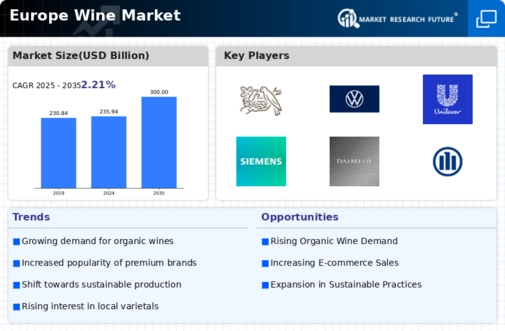The Europe Wine Market is characterized by a diverse array of wineries, varying from large multinational corporations to small, family-owned estates. This competitive landscape is shaped by factors such as consumer preferences, the growing trend of premiumization, and a rising interest in sustainable and organic wine production. Market players face challenges such as stringent regulations, climate change impacts, and competition from global markets. The demand for wine in Europe is dynamically affected by evolving lifestyle choices, health trends, and cultural influences, leading companies to innovate in their offerings and marketing strategies.
To remain competitive, businesses are focusing on enhancing their brand positioning, expanding distribution channels, and investing in technology for production and marketing efficiencies.E and J Gallo Winery stands as a prominent player in the Europe Wine Market, leveraging its robust portfolio of brand offerings that cater to a wide spectrum of consumer tastes. The company's strategic approach emphasizes a strong commitment to quality and value, which resonates well with European consumers increasingly seeking premium wine experiences.
E and J Gallo Winery's strengths lie in its vast distribution network across the continent, allowing the brand to reach both traditional retail and e-commerce markets effectively. By understanding regional preferences and tailoring its wine selections accordingly, the company has fortified its market presence.
Additionally, E and J Gallo Winery is known for its innovative marketing initiatives, fostering brand loyalty and engaging consumers through digital platforms and experiential marketing campaigns tailored to the specific preferences of European wine enthusiasts.LVMH, renowned for its luxury goods, holds a significant stake in the Europe Wine Market through its esteemed portfolio of wines and spirits, which includes several leading brands. The company focuses on premium and super-premium wines, establishing its market presence with products that exemplify refinement and expertise in winemaking.
LVMH's strength lies in its exceptional branding strategies and the ability to command high price points due to brand heritage and perceived quality. The company continually expands its market share through targeted mergers and acquisitions, enhancing its presence in key European wine regions. These strategic moves not only integrate new brands into its portfolio but also enhance operational efficiencies through shared resources and expertise. LVMH's commitment to innovation and sustainability further bolsters its competitive edge, appealing to a growing demographic interested in environmentally friendly wine production methods within Europe.

















Leave a Comment